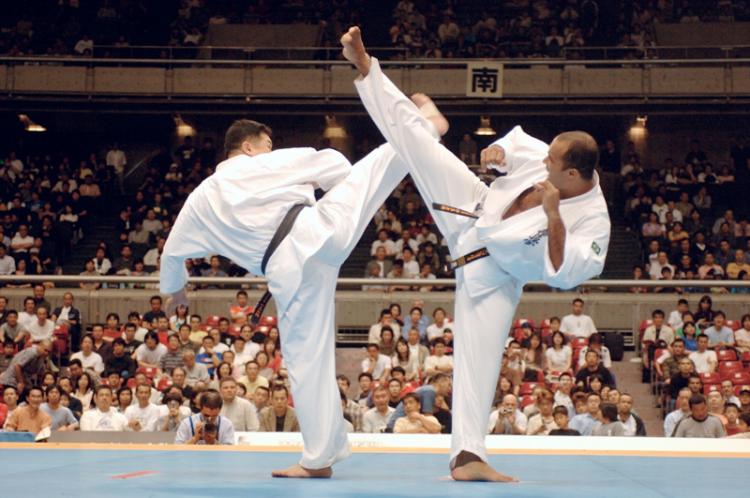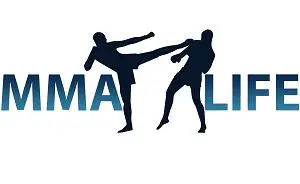The world of martial arts features a distinct variety of kicks. Each martial art has its own distinct style and technique to executing the kick, as well as strengths and drawbacks. Understanding the different kicking styles can help you improve your kicking game as well as mitigate your opponent's kicks.
We have put together an analysis of 4 popular martial arts. These martial arts showcase different kicking techniques, including Muay Thai, Karate, Tae Kwon Do, and Kung Fu. Keep in mind that each of these styles offers something different depending on what you want to learn.
Muay Thai Kicking Style

Muay Thai, also known as Thai boxing, is a martial art whose origin can be traced back to Thailand. Over the years, the benefits of this fighting style has seen increased popularity in western countries. Also known as 'The Art of Eight Limbs,' Muay Thai is a kickboxing style that incorporates hands, legs, knees, and elbows.
Muay Thai is one of the most prominent martial art styles in the world. Muay Thai incorporates the same punching and push-kick techniques used by other martial arts fighters, with an added twist to it known as the body-kick technique.
The body kick, also referred to as the roundhouse kick, generates a tremendous force originating from the practitioner's arm swing, hip rotation, and most importantly, the forward drive or the speed of the kick.

One thing that distinguishes the Thai roundhouse kick from other kicks is the use of the shinbone. Unlike different styles that employ the foot to kick, muay thai fighters utilize their shin. Muay Thai fighters use their shins to beat their opponent's legs down.The opponent is immobilized and unable to walk properly. They are also unable to put weight on the injured leg.
Lawrence Kenshin did a wonderful video analysis of the fight between Rick Roufus and Changpuek Kiatsongrit. "The Legendary Fight That Changed History." is the title of the video. The fight demonstrates the absolute monstrosity of muay thai leg kicks. You can watch the video below:
Though it takes a while to hone the skills of fighting with the shin properly, this technique helps the fighters break through their targets, giving them the upper hand in the boxing ring.
Karate Kicking Style

Arguably the most prominent martial style in the world, Karate holds its roots in Okinawa, Japan, where it emerged because of a blend between Chinese fighting styles and Okinawan fighting styles. The word karate means multiple styles categorized as one. The name emanates from two Japanese words: 'Kara' which means empty, and 'te', which means hand.
One can divide Karate into three categories:
- Kumite (sparring)
- Kihon drilling of stances, punches, blocks, kicks, and strikes
- Kata, which refers to prior forms that stimulate a combat environment).
Through each of these categories, novices are given instructions to follow from the basic level all the way, until their abilities become spontaneous.
Why Is Karate the Most Prominent Martial Art Sport in the World?
One can practice Karate for numerous reasons. Although, the Japanese primarily developed the sport karate as a self-defense mechanism. Besides, Karate has helped many people improve their mental health; develop self-confidence, composure, and a deeper insight into one's mental capabilities.
It is also worth noting that Karate has helped a manifold of people achieve and maintain good physical health. This is through developing coordination, toning the body, building stamina as well as stimulating reflexes. It takes quite a long time to master the skills and become a master in this martial art, though.
Though used interchangeably by some, Karate and Taekwondo are two distinct sports. While there lay a few similarities between the two martial art styles, one note of distinction is in that Karate emphasizes on punches and strikes while Taekwondo thrives on the use of kicks as explained further below. Some of the kicks used in karate include:
Basic Karate Kicks
- Front Kick – This stance involves the practitioner raising their foot and knee and striking their opponent by extending the leg at the height of their choice.
- Back Kick – Popularly referred to as the donkey kick, the practitioner launches the leg backward in a slight arch to hit the opponent by surprise.
- Side Kick - The practitioner uses the heel or edge of the foot to strike the opponent. They perform the kick in a diagonal position to hit the target.
- Roundhouse Kick - Practitioners perform the roundhouse kick by chambering the knee then extending the leg forcefully. This is an extremely deceptive kick as some may think that the kick will go to the body because the knee is chambered first. MMA fighters use a similar kick called the question mark kick. With a karate roundhouse kick, you hit with your forefoot.
Advanced Karate Kicks
- Axe Kick – This kick features an upward crescent kick in either an upward or an inward motion. The practitioner attacks the opponent in an upward motion.
- Calf Kick – Practitioners perform this kick like a low roundhouse kick aimed to hit the opponent's calf with the shin.
- Reverse Roundhouse Kick - Popularly called a spinning back roundhouse, this kick uses the heel as its defense tool to strike the opponent.
The Karate Front Kick Versus The Muay Thai Teep
The Karate front kick, the Muay Thai push kick, and the Muay Thai Teep are pretty similar from the untrained eye. But if you pay close attention, you can identify some differences.
- The Karate kick is more of a snap kick, with your knee coming up first, and then you snap your lower leg upward and forward. You try to hit with the ball of your feet. When you make contact, your leg should pretty much be straight and parallel to the ground.
- With the Muay Thai teep, you use your hip to extend the kick, as opposed to using your leg to snap the kick.
- The Karate front kick has an upward motion, and the Muay Thai teep has more of a straight motion.
- Fighters use the teep as a jab to distract the opponent, get them off-balance, or keep your distance. Karate practitioners use the front kick as an offensive weapon primarily used to deliver pain.
Tae Kwon Do Kicking Style

Tae Kwon Do (TKD) is a Korean martial art style developed by General Choi Hong Hi. Soon after the liberation of South Korea, General Choi Hong Hi took up the role of teaching this armed forces sport. Since its conception, on April 11, 1955, Tae Kwon Do has come a long way.
Currently, it is the national sport of South Korea. Not to mention it is now a global sport seeing that it was incorporated in the Olympics in 1988.
Mastering this prominent martial art sport involves a combination of swift footwork and low resistance movement. Furthermore, the sport emphasizes on jumping and spinning kicks as well as head-height kicks. Tae Kwon Do is known for its quick kicks and agile kicks.
People practicing Tae Kwon Do are equally adept with both legs as sparring and competition involve switching stances quite a bit to throw the opponent off. People who train Karate or Muay Thai are much more rooted in their stance compared to Tae Kwon Do practitioners. So this means that TKD kicks are much quicker but less powerful. This is the tradeoff.
Popular Taekwondo Kicks:
- Taekwondo Axe Kick - The axe kick has the power to break a shoulder and knock out an opponent. An axe kick has the fighter aiming at the collarbone, which can easily break due to the massive force of the kick. This kick typically involves the practitioner raising their legs from the outside of the body similar to a crescent kick and then pull back the leg with the heel facing downwards.
- Front Kick – This is a straightforward kick learned at the basic level. This involves the fighter rotating their body in a 90-degree angle whilst raising their knees and stretching out their leg. This kick is used to push the attacker away, and has a lot of force to it.
- Side Kick - The sidekick is a powerful self-defense tactic, especially if aimed at the right place. This kick requires the practitioner to stretch out their leg, raise their knee, and rotate their body at a 90-degree angle. Using the heel to strike, this may exert more force.
- Back Kick – The back kick is the most appropriate kick when an opponent is charging at you. This is because the practitioner turns their body away from the opponent and counteracts by stretching their leg outwards towards the target with as much force as they can.
- Roundhouse Kick- This kick involves the use of the whole body. The practitioner is required to turn their hips, raise the knee, pivot the stationary foot and charge at the attacker at an either an 80 to 90-degree angle.
- Whip or Hook Kick – The hook kick is a powerful defense tactic in the right situation. It is performed when the practitioner raises their knee whilst stretching their leg outwards. The kick is then released in a dorsal arch.
- Reverse Side Kick – This kick is comparable to the back kick only with a slight twist to it. The practitioner has to turn their body further in order to hit the target with the heel. The trick to this is to have the foot pointing to the side instead of downwards to exert the right amount of force.
(Northern Shaolin) Kung Fu Kicking Style

Kung Fu is starting to pique people's interest now because of one specific fighter in the UFC, Zabit Magomedsharipov. He grew up training at a Kung Fu boarding school in Dagestan, and his unorthodox fighting style is continuing to perplex every opponent he faces.
Kung Fu is a broad term used to describe all Chinese martial arts. But the most popular kicking styles of Kung Fu practiced today are Northern Shaolin styles.
The Northern Shaolin styles put particular emphasis on deep and wide stances, quick advances, long-range techniques, agility, aggressive attacks, leaping techniques, kicking, and whirling circular blocks. These techniques are achieved through a variety of movements in the legwork, the use of different kicking techniques, particularly high kicks, as well as the use of acrobatics.
All kicks can be performed with the rear or front leg to exert the predetermined force in any given stance. The Northern Shaolin kicking technique is mainly divided into 3 main levels:
- Low Kicks – Generally, the most practical kicks for self-defense, low kicks target the attacker below the waist. Low kicks are efficient in helping learn foot positioning and balance.
- High Kicks – Needless to say, high kicks target the attacker above the waist. There are a number of kicks in this level with different variations kicks in terms of how one extends the leg, the tilting of the hips, or even the part of the leg the practitioner hits the attacker with.
- Leaping Kicks – These kicks involve the practitioner jumping into the air whilst launching a kick at the same time. Leaping kicks are taught at the last and advanced level of Northern Shaolin Kung Fu.
This system's kicks are definitely the most acrobatic, but that also makes the lot of them somewhat impractical. Trained Wu Shu fighters like Cung Le don't use most of the leaping kicks in competition. If you want to see an example of some of the kicks, watch the video below:
Which Martial Art Style Has The Most Acrobatic Kicks?
Compared to all other martial arts, Shaolin Kung Fu holds a top tier when it comes to acrobatic kicks. In fact, Shaolin Kung Fu boasts thirty-six kicking techniques with a variation in position to each kicking technique, thus putting it at the number one position.
Which Martial Art Style Has The Most Deceptive Kicks?
Tae Kwon Do is a kick-centric martial art and offers the most deceptive kicks. Particularly the spinning hook kick used in Tae Kwon Do can be a deceptive kick in the sense that when performed, it appears to miss the target before one snaps back to hit the heel with the foot taking the opponent by surprise.
Which Martial Art Style Has The Quickest Kicks?
In a ranking method, Kung Fu martial art takes up the top tier as the martial art style with the quickest kicks, followed by Tae Kwon Do, then Karate, and lastly, Muay Thai. Like any sports, speed focuses on the practitioner's physique; however, research has noted that speed can be improved depending on the tactics used. Kung Fu practitioners are trained for incredible speed.
Which Martial Art Style Has The Most Powerful Kicks?
In our opinion, we have to say, Muay Thai, as we aforementioned, the body kick technique used in Muay Thai boxing is strong enough to snap a rib or break bones. The shin is a much bigger bone than the forefoot---and Muay Thai guys mainly kick with the shins.
Final Thoughts
The four martial arts referenced above all have their own distinct philosophy when it comes to kicking.
Muay Thai and Karate's philosophy relies on a more rooted striking method, thereby allowing for more power and precision.
Tae Kwon Do and Kung Fu place emphasis on quick movement and agility, thereby allowing for fast and deceptive kicks.
Each kicking style has its strengths and drawbacks. But whichever martial art you choose to practice, please make sure that your instructor incorporates regular sparring into the curriculum.




